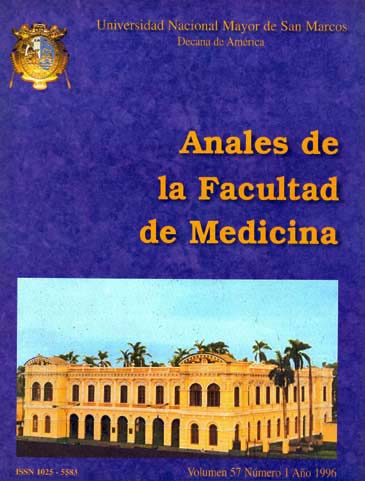Effect of delayed recanalization of occluded acute myocardial infarction-related artery using coronary angioplasty on late potentials
DOI:
https://doi.org/10.15381/anales.v57i1.4739Keywords:
Reperfucion, angioplasty, myocardial infarctionAbstract
Recent evidence suggests that late reperfusion of an occluded infarct-related artery (IRA) after acute myocardial acute infarction (MAI), may reduce the frecuency of subsequent arrhythmic events and sudden death. Mechanical reperfusion of an occluded IRA, performing percutaneous trasluminal coronary angioplasty (PTCA) 48 to 2 weeks after MAI, has a big success rate, and low symptomatic restenosis. Twenty subjects (19 men and 1 women, aged 32 to 77 year) with a first MAI, signal-averaged electrocardiographic (SAECG), and an occluded IRA were prospectively identified. Late potentials were present in 14 patients after MAI. Eighteenth had a successful PTCA of the occluded IRA, 6 to 32 days after MAI. Follow-up SAECG was performed 1 to 8 days later. In the subgroup of 12 patients with successful reperfusion with an abnormal SAECG before PTCS, 7 (58,3%) showed resolution of late potentials at follow-up, the filtered QRS duration showed a significant reduction (112,1 ± 14,2 msec to 96,7 ± 12,6 msec, p=0,02), and there was a tendency for the root-mean-square voltage to increase and the duration of low amplitude signals < 40 µV to decrease after angioplasty. In contrast 2 patients with late potentials before PTCA and usuccessful reperfusion of the culprit vessel way reduce the incidence of abnormalities on the SAECG, if thhis will result in improved longterm survival awaits confirmations in a large trial.Downloads
Published
1996-03-18
Issue
Section
Trabajos originales
License
Copyright (c) 1996 Manuel Horna

This work is licensed under a Creative Commons Attribution-NonCommercial-ShareAlike 4.0 International License.
Those authors who have publications with this magazine accept the following terms:
- Authors will retain their copyrights and guarantee the journal the right of first publication of their work, which will be simultaneously subject to Creative Commons Attribution License that allows third parties to share the work as long as its author and its first publication this magazine are indicated.
- Authors may adopt other non-exclusive licensing agreements for the distribution of the version of the published work (eg, deposit it in an institutional electronic file or publish it in a monographic volume) provided that the initial publication in this magazine is indicated.
- Authors are allowed and recommended to disseminate their work over the Internet (eg: in institutional telematic archives or on their website) before and during the submission process, which It can produce interesting exchanges and increase quotes from the published work. (See El efecto del acceso abierto ).
How to Cite
1.
Horna M. Effect of delayed recanalization of occluded acute myocardial infarction-related artery using coronary angioplasty on late potentials. An Fac med [Internet]. 1996 Mar. 18 [cited 2024 Aug. 16];57(1):7-13. Available from: https://revistasinvestigacion.unmsm.edu.pe/index.php/anales/article/view/4739















